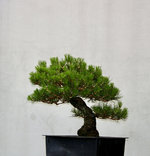I think you have to decide if the trees are worth it to you? Is it a tree that you can improve your skills with. Are there flaws that are beyond your ability to improve on? You here it a lot about buying a trunk… I do have a bias, but I am confident in grafting and don’t mind trees that don’t fit the “perfect” mould. I have found here no matter what tree you post somebody won’t like it.
I think it is simply a question of value received for the amount paid.
you are correct in that skills can be improved on almost any material regardless of cost. Flaws exist in almost every tree, but they should be fewer in those that are higher priced. You are also right in that grafting is a great skill to have and can significantly improve lower quality material.
Most importantly buyers should improve their ability to " grade " material and place an appropriate value on its acquisition. As a grower and seller of pines I definitely have a bias towards receiving fair value for the product produced . But as a grower I have an equally important responsibility to ensure the client understands the value of what they are considering for purchase and what lies ahead for development.
I think too often purchasers place too high a premium on age and size of trunk, while down playing the fundamentals of quality of nebari, trunk shape, movement and taper.
Branches and foliage can be more easily corrected. I also understand that a grower wishes to obtain some value for trees they have grown out for fifteen years even if they have not done such a good job of developing important characteristics. Those trees can be sold for lesser amounts with full disclosure to enthusiasts with the skills or motivation to learn how to correct them.
Regardless of the positive or negative reviews on Bonsai Nut, I think the design fundamentals should be in place for a pre bonsai pine in the price range being discussed in this thread.
I have seen lots of better quality material in several nurseries in Washington, Oregon and California for half that amount. I have also seen poor quality material for higher prices. One definitely needs to be aware of what is worth what. That is the question being asked in this thread. Do you believe the material posted is worth that amount?
I would suggest checking out younger material for better value. Be prepared to compare lots of trees and take your time. Do it in person if at all possible, photos can be difficult to properly judge value. Younger material is not as old or perhaps as thick but that is only a few years away with proper care and grow out technique. I would focus on 7-10 year old stock in the $150 to $250 price range and then continue to develop on for four or five years. You can learn a ton about proper care and development of pines over that time and end up with better quality material.
The tree below was priced at $350 USD. the picture show rough branch development but the trunk was in place when purchased. The second picture shows progression three years later! Just one example.
Another option is to have a trusted, knowledgeable person pick out material for you or with you! Could be the beginning of ongoing assistance in development of your tree and growth in the hobby.
The seller can place any value they wish on pre bonsai, the buyer has the same privilege. It works best if both are knowledgeable and understand what the value is based on. If the price includes a higher value pot, or considerable shipping charges and the purchaser understands that, then all is good. Whenever possible I try to encourage individuals to select and begin with the best material possible within their budget.


